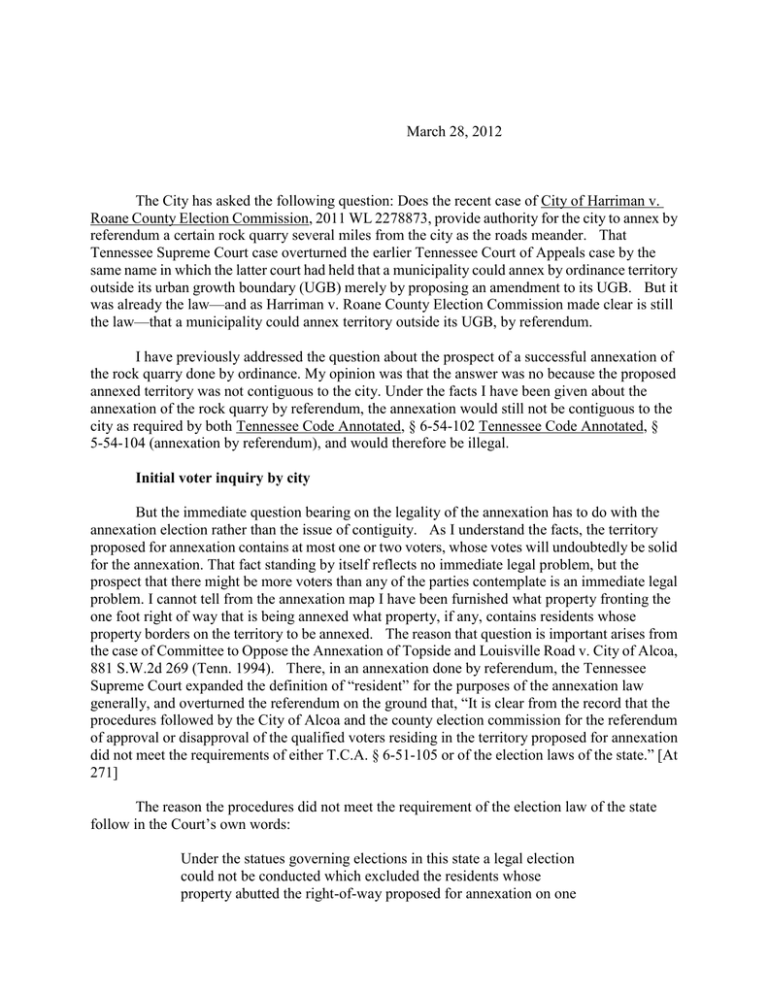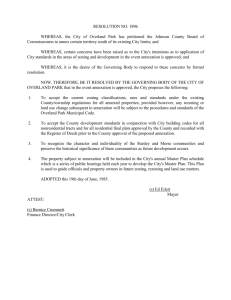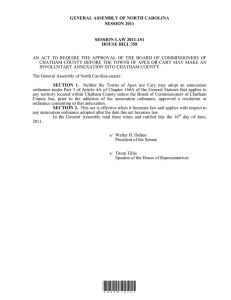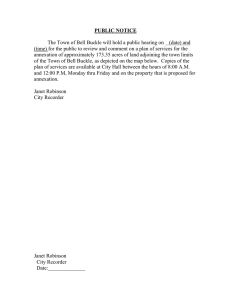March 28, 2012
advertisement

March 28, 2012 The City has asked the following question: Does the recent case of City of Harriman v. Roane County Election Commission, 2011 WL 2278873, provide authority for the city to annex by referendum a certain rock quarry several miles from the city as the roads meander. That Tennessee Supreme Court case overturned the earlier Tennessee Court of Appeals case by the same name in which the latter court had held that a municipality could annex by ordinance territory outside its urban growth boundary (UGB) merely by proposing an amendment to its UGB. But it was already the law—and as Harriman v. Roane County Election Commission made clear is still the law—that a municipality could annex territory outside its UGB, by referendum. I have previously addressed the question about the prospect of a successful annexation of the rock quarry done by ordinance. My opinion was that the answer was no because the proposed annexed territory was not contiguous to the city. Under the facts I have been given about the annexation of the rock quarry by referendum, the annexation would still not be contiguous to the city as required by both Tennessee Code Annotated, § 6-54-102 Tennessee Code Annotated, § 5-54-104 (annexation by referendum), and would therefore be illegal. Initial voter inquiry by city But the immediate question bearing on the legality of the annexation has to do with the annexation election rather than the issue of contiguity. As I understand the facts, the territory proposed for annexation contains at most one or two voters, whose votes will undoubtedly be solid for the annexation. That fact standing by itself reflects no immediate legal problem, but the prospect that there might be more voters than any of the parties contemplate is an immediate legal problem. I cannot tell from the annexation map I have been furnished what property fronting the one foot right of way that is being annexed what property, if any, contains residents whose property borders on the territory to be annexed. The reason that question is important arises from the case of Committee to Oppose the Annexation of Topside and Louisville Road v. City of Alcoa, 881 S.W.2d 269 (Tenn. 1994). There, in an annexation done by referendum, the Tennessee Supreme Court expanded the definition of “resident” for the purposes of the annexation law generally, and overturned the referendum on the ground that, “It is clear from the record that the procedures followed by the City of Alcoa and the county election commission for the referendum of approval or disapproval of the qualified voters residing in the territory proposed for annexation did not meet the requirements of either T.C.A. § 6-51-105 or of the election laws of the state.” [At 271] The reason the procedures did not meet the requirement of the election law of the state follow in the Court’s own words: Under the statues governing elections in this state a legal election could not be conducted which excluded the residents whose property abutted the right-of-way proposed for annexation on one side and included the property owners on the opposite side. The right to vote is fixed by the precinct in which they reside ad not on which side of the road they may live. The Court of appeals recognized that some of the aggrieved property owners have their dwelling houses upon parcels of land lying partially within the area to be annexed and that the determination of a person’s residence under our election code is provided n T.C.A.§ 2-2-122(a)…. [At 272] In determining that the procedures violated T.C.A. 6-51-105(a), the court rejected both the Court of Appeal’s and the Tennessee Attorney General’s opinions, that “where a portion of a person’s property is included within the proposed area of annexation but the structure of the residence of that person in not included within the proposed area of annexation, such person does not ‘reside in the territory proposed for annexation.” [At 272] The rule, announced the Tennessee Supreme Court, is that: We are of the opinion that under the provisions of T.C.A. § 6-51-105 residency includes the curtilage of the qualified voters who reside in the territory proposed for annexation. In this instance, those residents along the right-of-way whose curtilage extends into the territory proposed for annexation were entitled to vote in the referendum. [At 272] The Court provided several definitions of “curtilage:” Although commonly discussed in Fourth Amendment terms, curtilage is defined in 25 C.J.S as having a well defined legal meaning in the administration of both civil and criminal law. In terms of use, "curtilage” is defined as a space necessary and convenient and habitually used for the family purposes and carrying on of domestic employments; the space of ground adjoining the dwelling house, used in connection therewith in the conduct of family affairs and for carrying of domestic purposes; the ground adjacent to a dwelling house and used in connection therewith; the yard, or the ground or the yard or field which is near to, and used in connection with, the dwelling. See Welch v. State, 289 S.W.510, 511, 154 Tenn. 60 (1926). This Court in State v. Prier, 725 S.W.2d 67, 670 (Tenn. 1987), discussed the common law definition of curtilage as “the area to which extends the intimate activity associated with the “sanctity of a man’s home and privacies of life.’” Black’s Law Dictionary, Fifth edition, 1979, p. 346, includes a more comprehensive definition. “A piece of ground commonly used with the dwelling house. A small piece of land, not necessarily enclosed, around the dwelling house, and generally includes the buildings used for domestic purposes in the conduct of family affairs. A courtyard or the space of ground adjoining the dwelling house, necessary and convenient and habitually used for family purposes and the carrying on of domestic employments. A piece of ground within the common enclosure belonging to a dwelling house, and enjoyed with it, for its more convenient occupation. [At 272-73] It seems prudent for the city to make an initial determination of how many persons might be qualified voters in the territory to be annexed (obviously taking into consideration of who may reside along the right-of-way, and taking into consideration those residents’ curtilage); otherwise, the annexation may fail for denying voters the right to vote on the annexation. Assuming that the proposed annexation is on proper track from a voter perspective, the city still should consider what I believe is the likelihood that the annexation is not contiguous with the city. But in consideration of the limited judicial review presently accorded annexations by referendum the courts might be required to broaden their scope of that review, which I am quite confident they would do if confronted with the question of whether this annexation were legal. As I understand those facts, the annexation takes in a one foot wide corridor running approximately 6.5 miles down county roads, and meandering left down this road, right down this road, and so on, for the indicated distance. I previously said that the suggestion that such an annexation was contiguous to the city under Tennessee law reflected a legal fantasy that would produce what the Tennessee courts have called an “archipelagic monstrosity,” and would ultimately be held illegal. I still believe that is the case with respect to an annexation of the property by referendum. The meaning of contiguity in annexations Tennessee’s annexation law does not mention the word “contiguous.” Tennessee Code Annotated, § 6-51-102, speaking of annexation by ordinance, says: “A municipality...may extend its corporate limits by annexation of such territory adjoining its existing boundaries....” Tennessee Code Annotated, 6-51-104, speaking of annexation by referendum, says, “A municipality...may propose extension of its corporate limits by annexation of territory adjoining to its existing boundaries.” But the Tennessee courts in Town of Bartlett v. City of Memphis, 482 S.W.2d 782, and State ex rel. Maury County Farmers Co-Op Corp. v. City of Columbia, 362 S.W.2d 210 (1962), expressly point to a requirement that “adjoining,” or “adjoining to” in the clear sense that those words mean “contiguous” in the sense of touching the city. The word “Contiguous” is defined by Black’s Law Dictionary, 6th Ed. 1990, as “In close proximity; neighboring, adjoining; near in succession; in actual contact touching at a point or along a boundary; bounded or traversed by. The term is not synonymous with ‘vicinal.’” But in State ex rel. Earhart v. City of Bristol, 970 S.W.2d 948 (Tenn. 1998), the Tennessee Supreme Court expanded the meaning of “contiguous.” There the Court held that Tennessee Code Annotated, section 6-51-103, which limited quo warranto annexation challenges to property owners inside the annexed territory and within 30 days of the date of annexation, applied only to challenges based on the reasonableness of the annexation. It permitted property owners annexed in 1995 by the City of Bristol to challenge a corridor annexation adopted in 1989, and to which the territory annexed in 1995 was attached. Citing State ex rel. Collier v. City of Pigeon Forge, 599 S.W.2d 545 (Tenn. 1980), the Court frowned upon corridor annexations, declaring that, “As in any annexation, and more particularly one wherein a geometrically irregular parcel of land is annexed, the Court must scrutinize the stated and ostensible purpose of the annexation.” [At 995] The geometrically irregular parcel of land in this case involved the 1989 corridor annexation that did not take in people, private property or commercial activity, but which touched the city. The court said about contiguity in connection with such annexations that: The majority of courts have interpreted the requirement that the annexed area be “contiguous” to not allow the annexation of thin strips of land to connect a larger parcel of land to a municipality. [Citation omitted.] These decisions articulate the principle implicit in the Tennessee statute. [At 954.] Earlier, the concept of an annexation creating a “archipelagic monstrosity” appeared in City of Kingsport v. State ex rel. Crown Enterprises, Inc., 562 S.W.2d 808 (Tenn. 1978). There Crown Enterprises challenged Kingsport’s annexation of 806 acres, which included within that acreage Crown Enterprise’s 85-acre industrial park. The trial court found the annexation unreasonable for several reasons, one of which was the 85 acre site did not need city services. The Tennessee Supreme Court rejected the trial court’s view, declaring that: The whole process of annexation would be frustrated if the city could only annex those properties then in need of city services. The result of this would tend to create islands of unincorporated areas within a city and the archipelagic monstrosity thus created would thwart the rendition of essential city services and would not be in the public interest. Appellees do not contest the annexation of the remaining property. Should we uphold their contention the result would be the creation of an 85 acre island or enclave, completely surrounded by the City of Kingsport. This area thus omitted would be within, but not a part of a city. Absent the most compelling considerations, such a situation would be intolerable and an annexation that produced such a result would not meet the test of reasonableness. [At 814.] [Emphasis is mine.] Annexations that leave what are called donut holes, or islands are usually “contiguous” to the city in the sense that the annexed territory actually touches the municipal boundaries; they are usually surrounded by those boundaries. The same is true of “balloon”, “corridor,” “string”, and “shoestring” annexations; one end of the balloon, corridor, string or shoestring usually touches the annexing municipality. But they are generally not contiguous for the purposes of Tennessee annexation law, or the law of numerous other states, for that matter. [See Anno: What Land is Contiguous or Adjacent to Municipality so as to be Subject to Annexation, 49 A.L.R.3d 589 (1972).] But as far as I can determine, with one exception, Tennessee annexation law takes up the question of whether an annexation is contiguous only in cases of annexation by ordinance. That fact is important because of the generally limited judicial review that appears to apply to annexations by referendum in Tennessee. Contiguity in an annexation by referendum was an issue in Smith v. Town of Church Hill, 828 S.W.2d 385 (Tenn. Ct. App. 1991). Indeed, it was a major issue considered by the court in determining whether the annexation reflected a valid 14th Amendment challenge to the annexation, which appears to presently be the only grounds upon which an annexation by referendum can be challenged in Tennessee. In the court’s own words: The Smiths do not challenge the constitutionality of T.C.A § 6-51-104 or § 6-51-105 (which govern annexation by referendum) under which their property was annexed, nor do they contend that the Town did not properly follow the statutes in the annexation proceedings. Their sole contention relates to a small area where the portion of the Smith farm which was annexed in 1986 borders on the west bank of the Holston River. Even though the 126 acres of the Smith farm which was taken into the Town in 1986 border on and are contiguous with the subdivision together with the remaining portion of the Smith Farm, the Smiths contend this creates a corridor of narrow strip of land which was included in the annexation for the sole purpose of making the land in the subdivision contiguous with the Smith farm. In their brief, the Smiths cite the dictum of the court in the case of State ex rel. Collier v. City of Pigeon Forge, 599 S.W.2d 545 (Tenn. 1980) as supportive of their contention. [At 387] In Collier v. City of Pigeon Forge, the dictum to which the court referred said: We should emphasize that this is nor, as appellants insist, merely a “strip” or “shoestring” or “corridor” annexation, although it is long and lean. Such annexations, so long as they take in people, private property or commercial activities, and rest on some rational basis, are not per se to be condemned. We do not deal with an annexation wherein a city attempts to run its corporate limits down the right-of-way of an established road without taking in a single piece of property. Such an annexation it is perhaps questionable and is not here involved. As in any annexation, and more particularly one where a geometrically irregular parcel of land is annexed, the Court must scrutinize the stated and ostensible purpose of the annexation. (Emphasis ours [the court’s] [At 387] But the Smith court declared that, “Nor are we dealing with that kind of situation in the case at bar [Smith].” The court made that claim by pointing to a map of the annexed territory at issue: A map of the annexed territory shows it begins at the corporate limits along the north end of the subdivision near the western bank of the Holston river; thence in an easterly direction crossing the Holston River to its east bank; thence with the meanderings of the east bank of the river in a southeasterly and a northwesterly direction some 16,000 feet; thence crossing the river to the Town corporate limits; encompassing some 1,096 acres all of which has as its inner boundary line the corporate boundary line of the Town and as its outer boundary line the east bank of the Holston River. All of the property is within one mile of the Town hall. [At 386] The court concluded that the annexed territory was contiguous to the city, made so by the connection of the subdivision and the farm by the river bed. Interestingly, it also concluded that, “All of the property was within one mile of the Town hall. [At 386] Smith was not concerned with Pigeon Forge and Crown enterprises, above, which respectively which raised the specter of “geometrically irregular” annexations and annexations that create an “archipelagic monstrosity” (even though in the case of corridor annexations they may take in persons, property and commercial enterprises). Or if it was concerned, found the annexation contiguous even though two separate pieces of annexed land were connected by a river bed, which ran 16,000 feet. . But it appears to me that there is a big difference between the annexation in Smith and the one being considered in your City. The annexation in Smith involved what appears to be a compact annexation of a “corridor”—the river bed--, the 16,000 feet of which drew the entire annexed territory together in contiguity with the city. The corridor in your City’s proposed annexation extends 6-1/2 miles, much of it only one foot wide. That corridor zig-zags a great distance between the existing city and the rock quarry. The corridor in Smith could hardly be said to be a “geometrically irregular” annexation or to produce an “archipelagic monstrosity” but the proposed annexation appears to me to be as close to meeting both as an annexation can get. The problem of plaintiffs in annexation by referendum cases The question at this point is: what kind of issues can be raised about contiguity in annexations by referendum? As indicated above, the contiguity question arose in Smith only with respect to whether the connection of the territories at issue by the river bed reflected a Fourteenth Amendment Due Process or Equal Protection violation with respect to the plaintiffs. Frankly, I have not had time to research or otherwise consider exactly how such a violation would arise in an annexation by referendum case, outside of annexation referendum problems such as were an issue in Committee to Oppose the Annexation of Topside and Louisville Road. But if I am correct that the annexation of the kind proposed by the City violates the contiguity requirement of the annexation by referendum law contained in Tennessee Code Annotated, § 6-51-105, it is still not clear to me whether that violation, standing alone, can even be challenged before or after an annexation by referendum, let alone determine how it creates a Fourteenth Amendment problem. But let me make it clear here, that if the city denies residents in the area proposed for annexation the right to vote if they are otherwise qualified voters, those persons undoubtedly have Fourteenth Amendment Due Process and Equal Protection claims, not to mention claims under Committee to Oppose…, which, incidentally, mentioned only the state election law and the annexation law as a basis for such claims. Smith was based on State ex rel. Vicars v. Kingsport, 659 S.W.2d 367 (Tenn. App. 1983). A reading of that case indicates that it might not have even allowed a challenge to an annexation by referendum based solely on its lack of contiguity (but as pointed out above, Smith did). The Vicars court rejected a challenge to an annexation done by referendum. The plaintiffs in that case argued that an annexation referendum was held in which the annexation was soundly defeated. Shortly thereafter, the city “redefined” the boundaries of the annexation to include more citizens in favor of the annexation. At the second referendum, the annexation was successful. The city argued that an annexation by referendum is not subject to review by the courts, “since our statutes only expressly authorize court review in annexation by ordinance cases.” [At 368] The court held that an annexation by referendum was reviewable by the courts on constitutional grounds, apparently “if the evidence establishes constitutional infirmities either in the adoption of a resolution calling for a referendum or in the election process.” [At 369] But the court found no constitutional infirmities in the annexation, citing State ex rel. Wood v. City of Memphis, 510 S.W.2d 889 (Tenn. 1974), and declaring that, “In the Wood case, our Supreme Court held, ‘Moreover, in annexation cases, there is no equal protection or due process argument that can properly be made when the statute is properly followed.’ As we have said, in this case the city followed the statute.” [At 370] But presumably the annexation was contiguous to the existing city in that case. Had that not been so, the city would not have followed Tennessee Code Annotated, § 6-51-104. But Smith does stand for the proposition that contiguity in an annexation by referendum is reviewable, but only for the question of whether the lack of contiguity somehow violates the plaintiff’s Fourteenth Amendment rights. However, I think a good argument can be made that what the court said in Bristol v. Earhart, above, and Highwoods Properties, Inc. v. City of Memphis, below, apply to annexations by referendum as well as annexations by ordinance, because those cases stand for the broad proposition that were there are no legal avenues available to challenge an annexation, equity will support such challenges. There are presently two ways to challenge annexations by ordinance: a quo warranto challenge based on the unreasonableness of the annexation, and a challenge under the Declaratory Judgments Act. Again, annexations by ordinance are subject to a quo warranto challenge, but annexations by referendum are not. It is said in Bristol v. Earhart, above, that But where the quo warranto proceeding is not available alternative equitable remedies are not barred. “[W]here the remedy by quo warranto is available, it is usually held that there is no concurrent remedy in equity, unless by virtue of statutory provision. But if quo warranto is not an adequate remedy, it will not be a bar to alternative remedies.” 65 Am Jur.2d Quo Warranto § 7 (1972) The availability of other remedies is specifically acknowledged in section 6-51-113 (1992), which provides, “Except as specifically provided in this part, the powers conferred by this part shall be in addition and supplemental to, and limitations imposed by this part shall not affect the powers conferred by any other general, special or local law.” The Tennessee Declaratory Judgment Act is just such another general law conferring the power to challenge the validity and construction of statutes and municipal ordinances.... [At 953] But in Highwoods Properties, Inc. v. City of Memphis, ____ S.W.3d ____, 2009 WL 2226091 (Tenn.) (July 27, 2009), above, the Tennessee Supreme Court did a comprehensive review of the development of annexation law in Tennessee, including the effect of the 1998 amendments to the annexation laws. That review says this about annexation in UGBs: A municipality may annex an area within its urban growth boundaries using methods established by the 1955 Act.... If, however, the municipality wishes to annex an area outside its growth boundaries, it must either propose an amendment to its growth boundaries or rely on the referendum annexation methods.....Thus, the 1998 Amendments reflect a balance. While, on one hand, the new restrictions discourage annexations that extend beyond a city’s predicted area of growth, on the other, the 1998 Amendments assure that a municipality will not bear the burden of proof in a quo warranto challenge when it does exercise its powers within predicted boundaries..... [At 8] [Emphasis is mine.] But the Court also drew a line around Declaratory Judgment Act suits in annexation cases, pointing to two conditions that it had imposed on such suits in Bristol v. Earhart: First, we permitted only challenges to ultra vires acts, that is, tests of “[t]he validity of an annexation ordinance alleged to exceed the authority delegated by the legislature.” Earhart, 970 S.E.2d at 954. Second, we stated that it is only “where the quo warranto proceedings is not available, [that] alternative equitable remedies are not barred. Id. At 952 (citing 65 Am.Jur.2d Quo Warranto § 7 (1972) (“Where the remedy by quo warranto is available, it is usually held that there is no concurrent remedy in equity, unless by virtue of statutory provision.”) [(Emphasis added (by court]) [At 10] Highwoods emphasized that Bristol v. Earhart involved a case where the absence of people in the annexed area meant that there would be no plaintiffs: no plaintiffs, no case, no case, no remedies for an ultra vires annexation. The court rejected Count 1 of the plaintiff’s claim, which was that plaintiffs in a quo warranto suit (which did not include the plaintiffs in Highwoods) attacking an annexation ordinance on the grounds of its reasonableness had settled that case, the result of which was a different annexation ordinance than the one originally challenged. The court declared that Count 1 did not satisfy either of the two conditions of declaratory judgments suits: They did not allege or show that the ordinance was void, and they had not filed a quo warranto suit. The court declared that they could have been plaintiffs in the quo warranto suit, that generally procedural issues in annexation cases belong in quo warranto challenges, and that “our limited holding in Earhart did not overrule the longstanding principle, articulated in those cases, that Tennessee courts have no authority to vacate an annexation based on procedural defects, except insofar as those defects bear on the questions presented in a timely filed quo warranto action.” [At 10] The Highwoods court did declare that Count 2 of the plaintiff’s complaint that the effect of the annexation resulted in unequal taxes in different areas of the annexation, in violation of Article II, Section 28 of the Tennessee Constitution, could go forward under the Declaratory Judgment Act suit (even though the court rejected the unequal tax claim). The reasons were obviously that the claim was a constitutional one, and that “Moreover, the Plaintiff’s allegations in Count 2 challenge the taxation scheme incident to the annexation and not to the propriety of the annexation itself.” [At 11] Under the facts of the proposed City annexation, there are no legal means for a challenge to that annexation. there being no statute that authorizes a challenge, and the courts having made an exception only for challenges on constitutional grounds. The immediate plaintiffs in an annexation by referendum could be expected to be the owners of the property in the proposed territory, but in this case they are the proponents of the annexation, and have made costly promises to the city to approve the annexation. From a policy standpoint, if nobody else (such as Committee to Oppose the Annexation…) can challenge the annexation except property owners only on Fourteenth Amendment grounds, there appears no reason that annexation far more distant from cities than 6-1/2 miles are possible, and even likely. It was said in Earhart, that, “The Tennessee Declaratory Judgment Act is just such another general law conferring the power to challenge the validity and construction of statutes and municipal ordinances....” [At 953] The Highwoods Court, speaking about Earhart, also said, “First, we permitted only challenges to ultra vires acts, that is, tests of “[t]he validity of an annexation ordinance alleged to exceed the authority delegated by the legislature.” Earhart, 970 S.E.2d at 954. Second, we stated that it is only “where the quo warranto proceedings is not available, [that] alternative equitable remedies are not barred.” It seems a short step for the courts to allow that vehicle to be used as an equitable remedy when the legal remedy for challenging an annexation by referendum is so narrow. The problem with using the Declaratory Judgments Act is that case law applying that Act requires the person making the challenge to the government action at issue to have standing. Generally, in order to achieve standing, a person must be able to show that he is injured by the action of the government in a way that is not common to the general public. It is not clear to me what kind of injury a person who is not an owner of the annexed property or a resident of the annexed area could show to achieve standing after the annexation referendum is successful. But it has been held that the Act is to be given a broad interpretation. Given the egregious circumstances surrounding the City annexation, it is difficult to believe that the Tennessee courts would simply throw up their hands if the annexation were challenged for the lack of contiguity by any organized group and perhaps other persons. Indeed, Bristol v. Earhart and Highwoods themselves contain language broad enough for those courts to find standing on the part of such groups and even individuals. Sincerely, Sidney D. Hemsley Senior Law Consultant SDH/




